 |
||
|
||
| ||
 CONTENTS
In July ATI launched a new super accelerator RADEON 9700 (earlier known as R300). First samples started shipping to the test labs only in August, and now we can get a wealth of information on various aspects of this RADEON. But traditionally, let me give you some links to the reviews related with the today's one: Theoretical materials and reviews of video cards which concern functional
properties of the VPU
Today we are going with another partner - Hercules and its baby 3D Prophet 9700 Pro. You will see later that the engineers worked hard on the design though it still follows the reference one. However, the card is not deprived of some curious peculiarities. Last time we touched upon availability of the RADEON 9700 and compared with the situation occurred a year ago that involved the RADEON 8500. If you remember, first RADEON 8500 (275 MHz) based samples were in very short supply and were selling at extravagant prices, in contrast to the RADEON 8500LE. Much larger amounts of the 8500LE cards almost pressed out that High-end solution RADEON 8500 275 MHz. The new ATI's policy of relations with partners which didn't seem to be strictly defined at that time and the first release of a 0.15micron chip which was planned to run at 250 MHz (and then was overclocked to 275 to be able to fight against GeForce3 Ti 500) add fuel to the fire. Last time I set the question of whether the situation could occur again, and answered it positively as the new design was quite complicated and the partners didn't have enough facilities given to the fact that first cards were to be produced at the same factory. The signs of today make me think that the situation is improving. First of all, RADEON 9700 Pro cards (325 MHz core) are freely available on the shelves and cards on the junior RADEON 9700 haven't been announced yet. Besides, Retail and OEM packages enclose samples running at equal frequencies. Moreover, the tests (ours and from other labs) show that almost all RADEON 9700 Pro chips overclock decently which means that the percentage of operable chips of ATI is high enough. That is why senior RADEON 9700 Pro cards will hardly be difficult to get. Finally, while the RADEON 8500 275 MHz sold at $300-310 in the beginning, now the price is higher by $100. Such a high price of the 3D king can't help weakening the demand which will have a definite effect on its shortage. The today's western market offers RADEON 9700 Pro at the price much lower than the recommended one ($399). Therefore, the release price of this product is relatively low, and the current price of $400-410 in our local market for the OEM package is set because this model is new. I'm sure in 2-3 weeks the prices will fall down to $350-390 as there is some reserve. We saw that the RADEON 9000 was first overpriced, and now the situation is being handled. Last time we took price tags from www.pricewatch.com. Now let's pop into www.price.ru. So, what's about the GeForce4 Ti 4600? The minimal price is $285 (Chaintech), the highest acceptable one is set to $350 (Leadtek/ASUS). So, the average is $317. At present the RADEON 9700 Pro ships only from Sapphire in the OEM box. The minimal price is $400. The maximum acceptable is $450. So, the average is $425. The price gap between the current 3D king and the former one GeForce4 Ti 4600 is 34%. Even if all rush into stores to get GeForce4 Ti 4600 from Chaintech or other companies selling them at lower prices and if we decrease the average price to $300, the RADEON 9700 Pro will still be dearer by 41%. And what about the performance in average? In the review on the Gigabyte MAYA II R9700 Pro we wrote: The new results are: the RADEON 9700 Pro outperforms the GeForce4 Ti 4600 without AA or anisotropy by 15.8% ON AVERAGE, with AA by 94.2%, with anisotropy by 62.8%, with AA and anisotropy by 64.4%.Even at the 40% price difference the new accelerator looks superior, which takes place first time. Earlier newcomers were often 50%(!) dearer with the performance boost being modest (about 25% in average). Why do I recommend that you look at the results involving AA and anisotropy? Because without them a central processor limits the overall performance, and those 15.8% is not an objective figure. And when the respective modes are switched on the final scores reveal the real capabilities of an accelerator. So, if you have spare $400 for a super accelerator study the BASICS OF 3D GRAPHICS to understand what is ANISOTROPIC FILTERING, TRILINEAR FILTERING and ANTI-ALIASING, that is the functions meant to improve image quality, make it more realistic, otherwise it makes no sense to pay through the nose for a card whose wonderful functions are going to remain disabled! At least, you should know they exist and turn them on at the level set to your liking. And now let's take a close look at the card itself. CardThe card has AGP x2/x4 interface, 128 MB DDR SDRAM located in 8 chips on both PCB sides.
This is a copy of the reference card in spite of different colors. The design is more complicated because of the 256bit high-speed bus (that is why until production of such expensive PCBs is mastered by the manufacturers all RADEON 9700 Pro will be as like as two peas in a pot). By the way, all Ti 4600 cards are based on the same design which, however, doesn't make them less interesting. The card is equipped with standard interface connectors: VGA, DVI and TV-out (S-Video). There is a special adapter to connect TV-out via RCA. Traditionally Hercules uses heatsinks on memory modules (we could see it on NVIDIA, RADEON 8500 and RADEON 9000 Pro based cards). This one has it as well. Besides, the back of the PCB incorporates a stylish tiny copper heatsink right under the chip. The distinguishing feature of this card is a massive copper cooler capping the graphics processor. All metallic parts are made of copper except the impeller which is simply painted in this style. I think this cooler is more efficient than the one installed on the reference card. 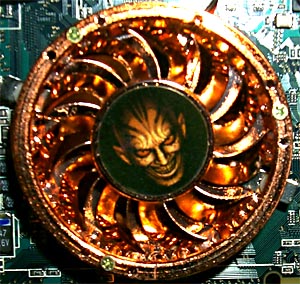 But I wonder whether such a heavy cooler attached with just two clips can guarantee no damages on the die since the R300 chip is produced not in a usual BGA package but with an open die? 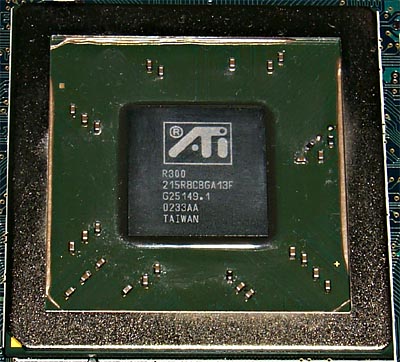 It does! The chip is enclosed into a metallic frame which is as high as the die or it maybe a tenth part of a millimeter lower. That is why the cooler is pressed closely against the die (that was seen well when we took off the heatsink: both had leftover of the grease), and it is not wrenched out of shape. The box has the following stuff: 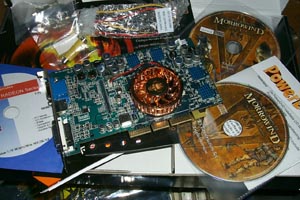 The first thing that attracts my attention is Elders Scrolls III: Morrowind (on two CDs!). It doesn't happen often when a video card comes with a fresh and popular game which uses modern capabilities of new cards, although with just DirectX 8.1. Besides, here we have a PowerDVD XP player, a CD with drivers, utilities, demos from ATI, a user manual and adapters. An excellent bundle! Kudos! Here is the package: 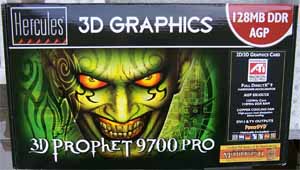 Why do they bind an image of a Prophet with something awful and wicked? That seems to be a strange tendency since the times of Voodoo. Everyone seems to be mad about Evil, Devil, Monster and so on and so forth. Why not to show a prophet kind, strong and lofty? OverclockingIf you think that copper coolers are a cure-all for pour overclocking potential, you are wrong. First of all, they guarantee a no-failure operation in the rated mode and reduce possible overheating. And only after that they can be used to up the speed. Such a chip, twice larger than the Athlon, requires proper cooling.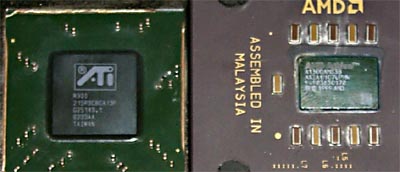
Note:
 Test system and driversTestbeds:
In the tests we used the ATI's latest drivers 6.159 and the new CATALYST 2.3 (2D driver version 6.166). VSync was off, texture compression was off (in games, not in driver settings), all texture detail settings were set to maximum (High Quality) both in Direct3D and in OpenGL. The following cards are taken for comparison:
Driver settingsThe new CATALYST 2.3 drivers, 2D version is 6.166, has altered settings; this time TRUEFORM can be adjusted: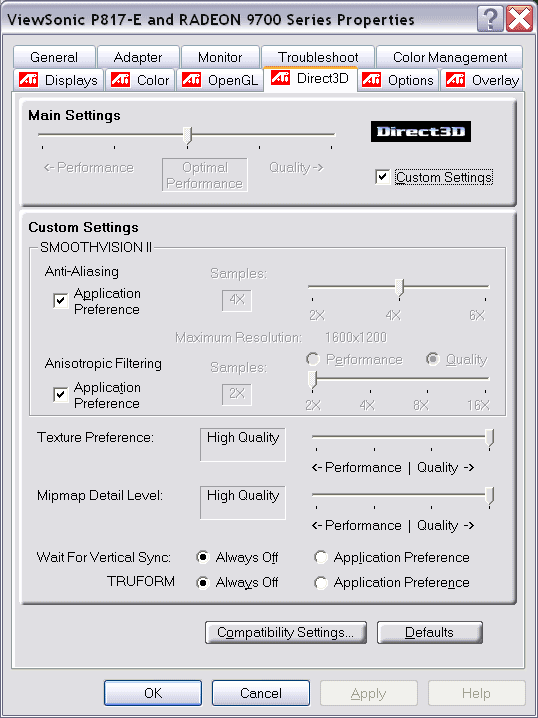
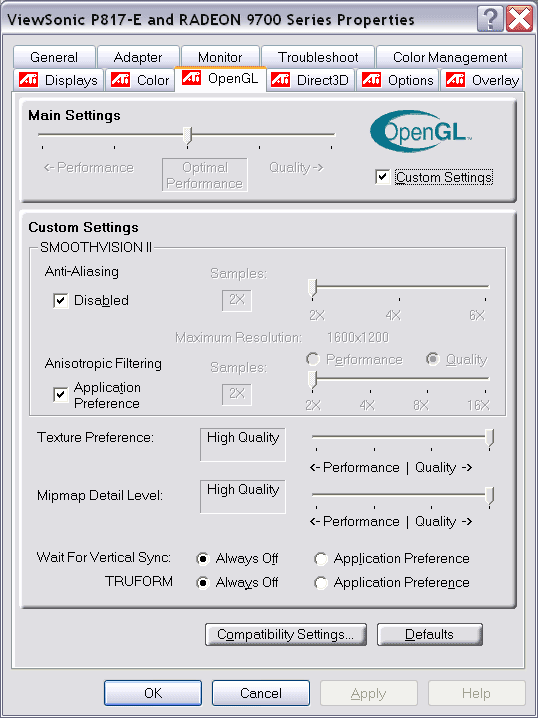 In spite of the release of the Detonator 40.41 by NVIDIA (which gained weight in terms of settings), the ATI's drivers are the best in capabilities and flexibility of settings. Test results2D graphicsI'm often told that I write too banal things, i.e. remarks are simply copied from one review to another. But what can I say else if it was said a lot of times and in different words? Well, if you want, imagine two fans of running, for example, two country sprinters who decided to make a competition just for the love. A cow mooed (a country sign to start), and two guys took off... Certainly, a country path always have puddles... And imagine that one of puddles have turpentine instead of water. One of the runners step into that strange puddle and starts flying at the light speed and soon drops out of sight... You will be really perplexed and admired watching that.Here the case is the same: all modern cards have recently stepped into turpentine and increased the 2D speed by a great margin. It doesn't even make sense to measure it as it's high enough for most cases. The RADEON 9700 is certainly shares the palm of supremacy. ... That guy was found on another river bank lying all in. His really frightened girl-friend was very happy that her lover was alive... When you are happy the whole world becomes better, more colorful and fruity. That's the impression we get from images drawn by the RADEON 9700. As I wrote last time, colors are richer here in contrast to competitors. 2D estimation is subjective. Quality depends on a sample, as well as on the card/monitor tandem. And first of all you should pay attention to quality of the monitor and cable. Finally, here are the figures. Coupled with the ViewSonic P817 monitor and BNC Bargo cable the tested sample performed brilliantly at the following resolutions and frequencies:
3D graphics, 3DMark2001 - game tests3DMark2001, 3DMARKS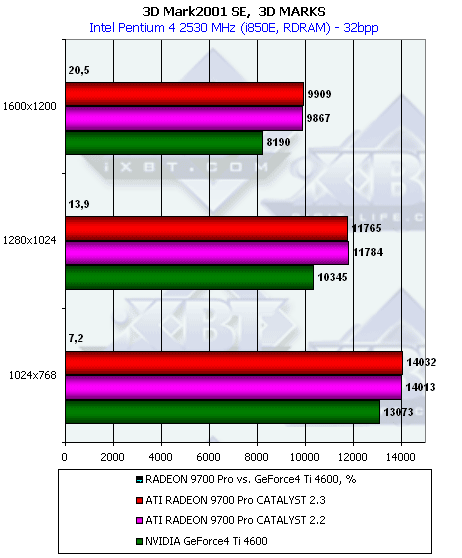
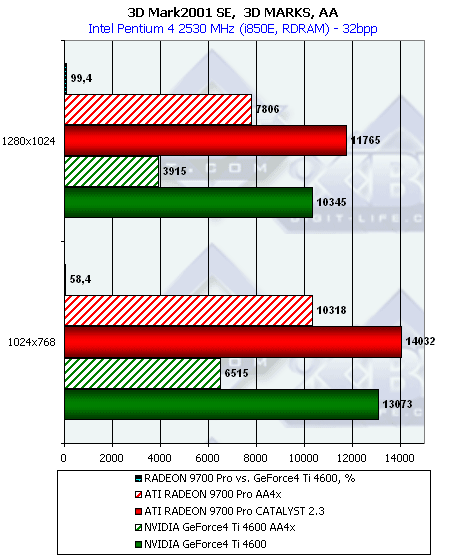 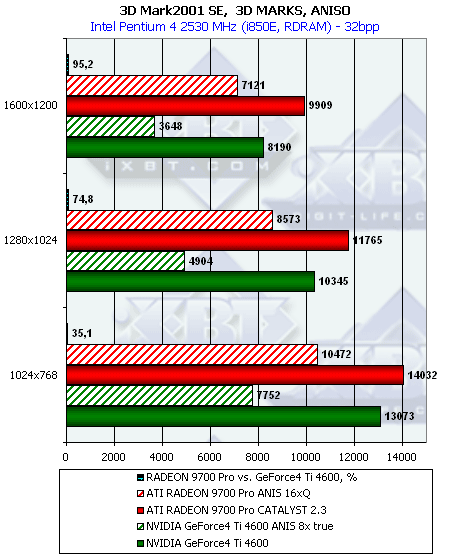
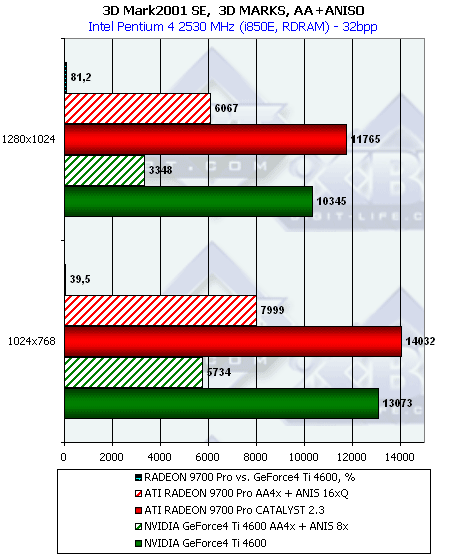 3DMark2001, Game1 Low details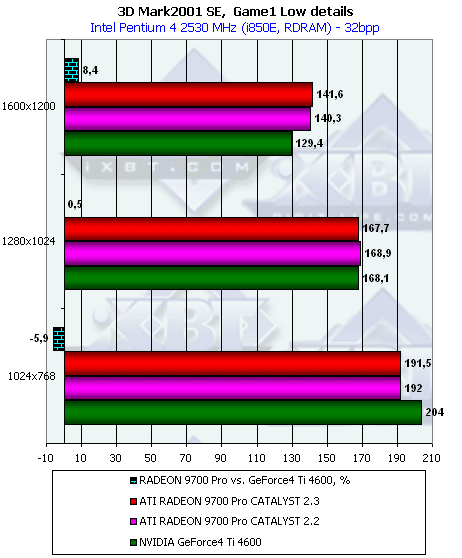
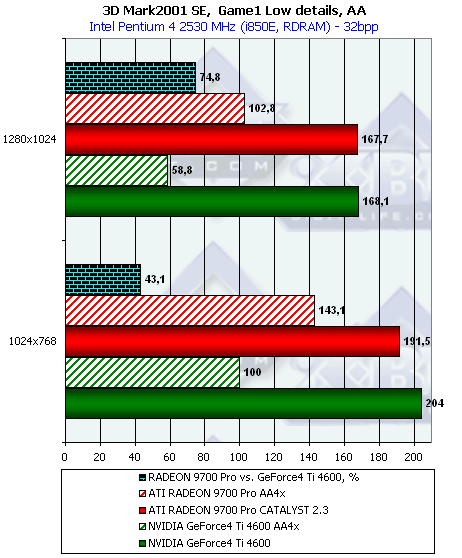 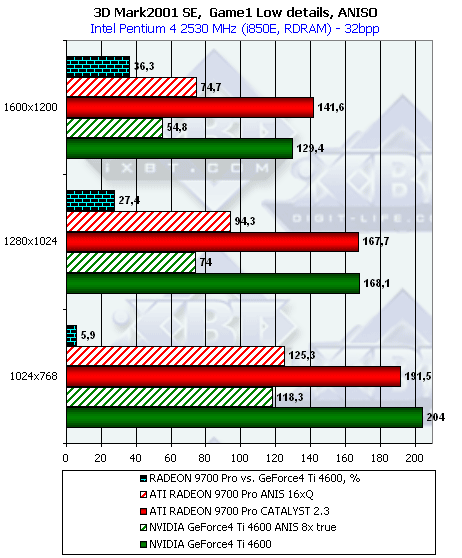
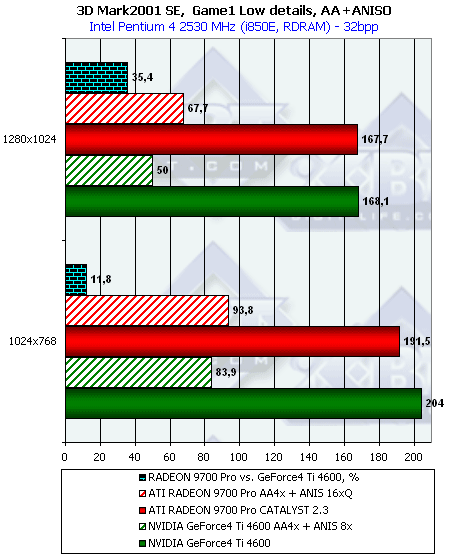
3DMark2001, Game2 Low details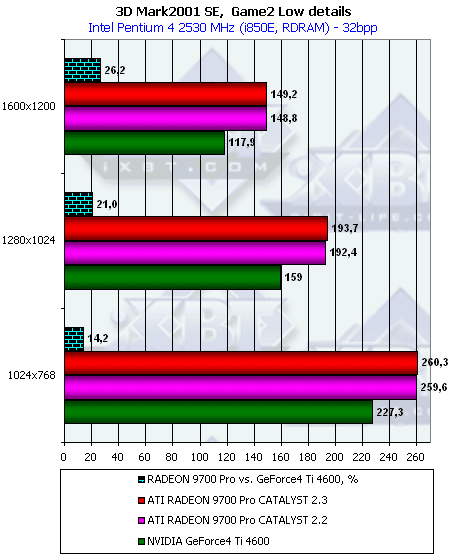
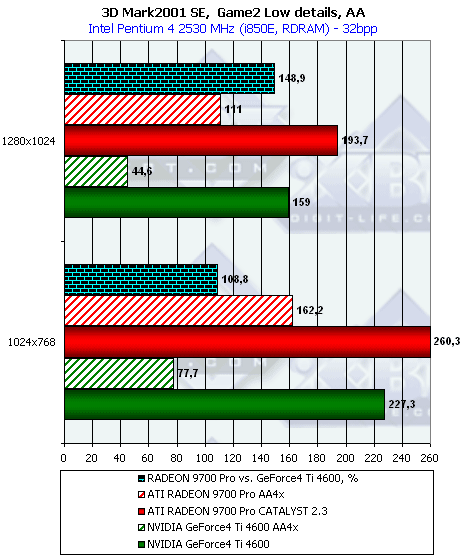 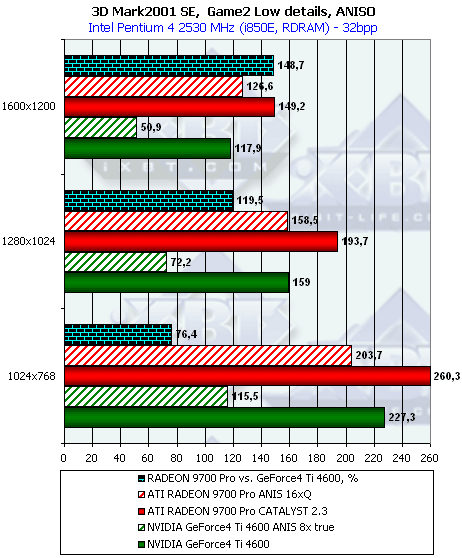
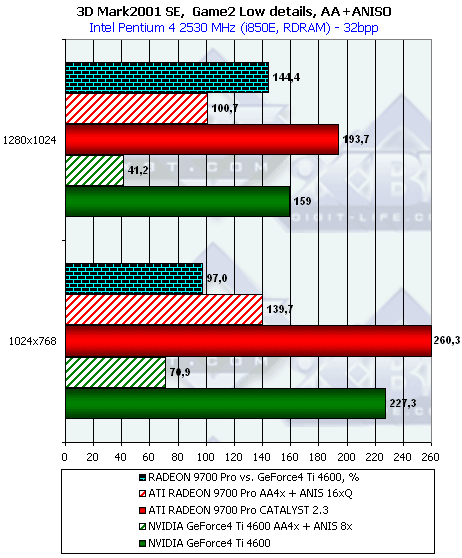
3DMark2001, Game3 Low details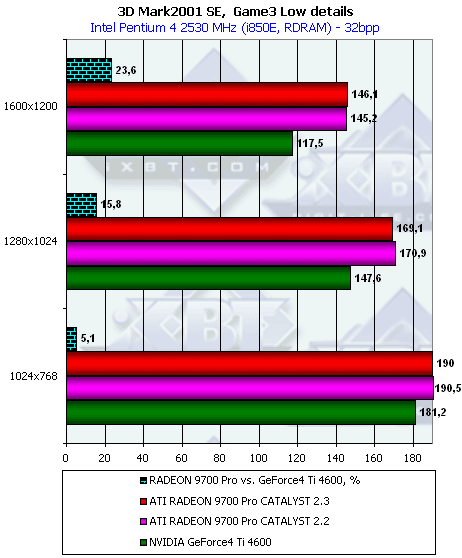
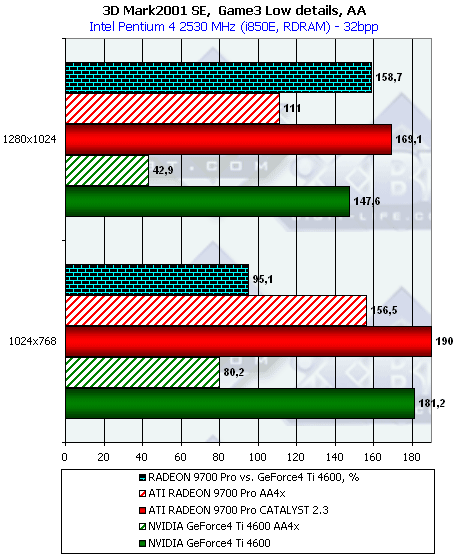 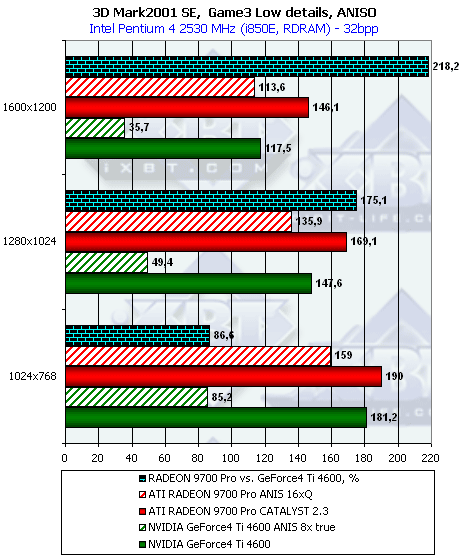
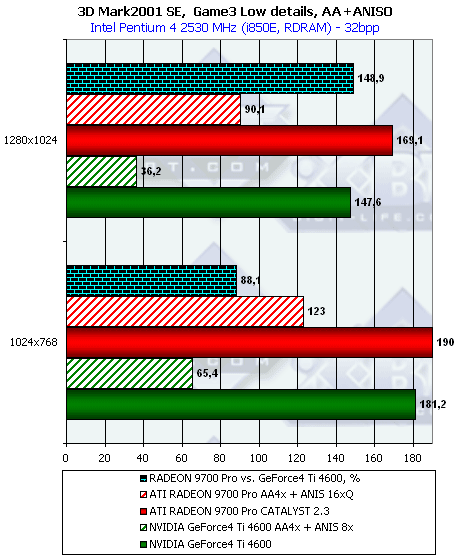
3DMark2001, Game4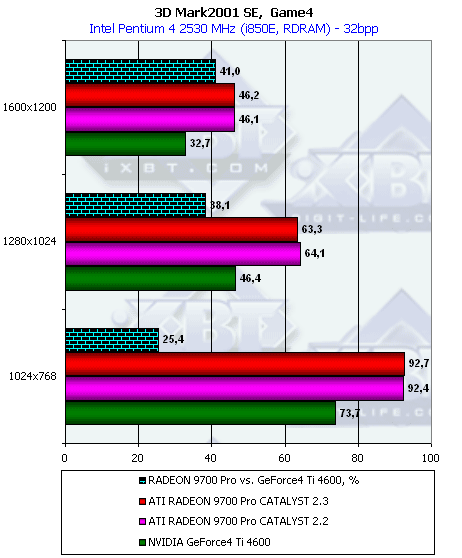
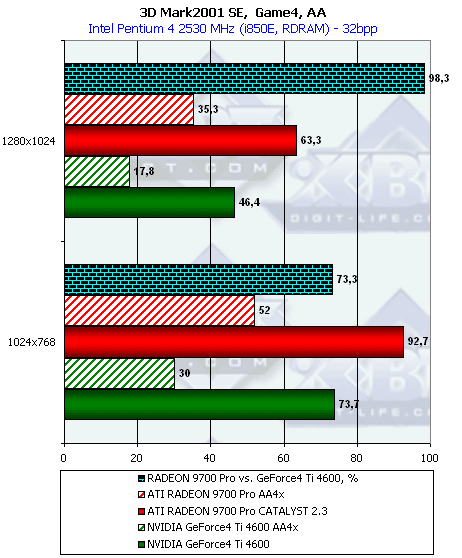 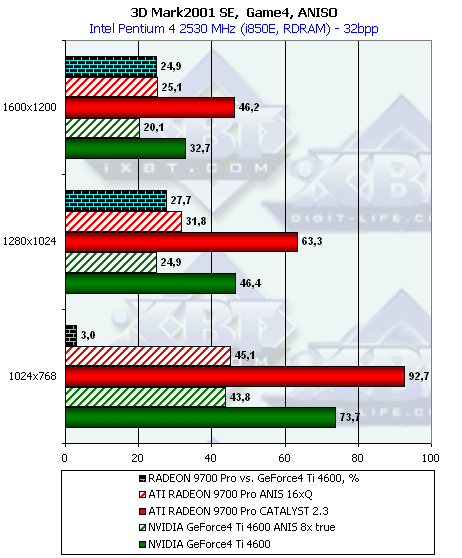
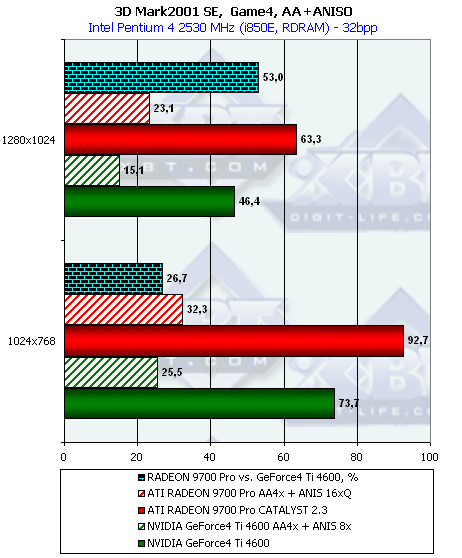
So,
3D graphics, game testsThis time we won't see into performance changes of the RADEON 9700 Pro running under the new drivers on some game tests. We will just estimate performance in the Unreal Tournament 2003 DEMO that was released not so long ago. Tests in the other games will be conducted next time, in the review of the RADEON 9700 Pro from CP.Technology (quality issues will also be highlighted).
Unreal Tournament 2003 DEMOThe recently released DEMO version of this game includes a weighty set of benchmarks. The Benchmark directory contains 7 BAT files, some of them start emulation of bot-matches, the others make the camera simply flying around the scenes. We tested all benchmarks and found that all bot-matches are extremely processor-independent. Evidently, the engine, which drives the game (not just 3D graphics), needs a very powerful central processor. That is why we had to refuse all bot-matches (some of them had even bugs in battles) and go with two scenes: CITADEL and ANTALUS.CITADEL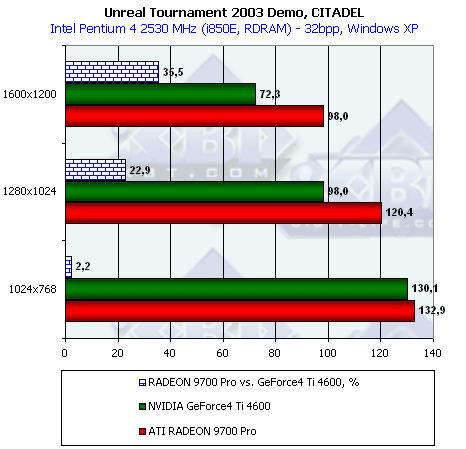
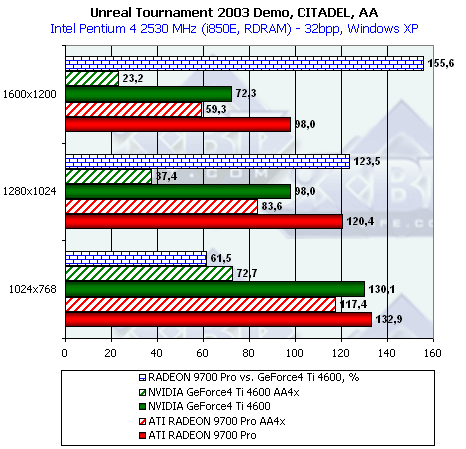 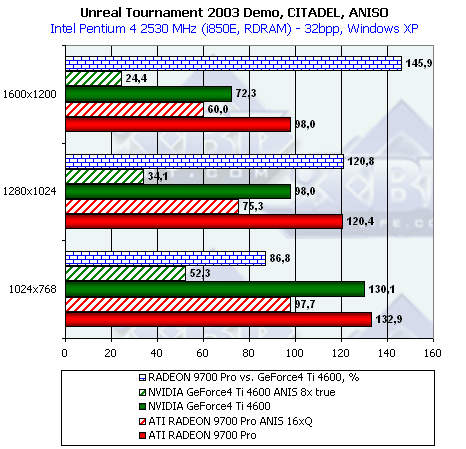
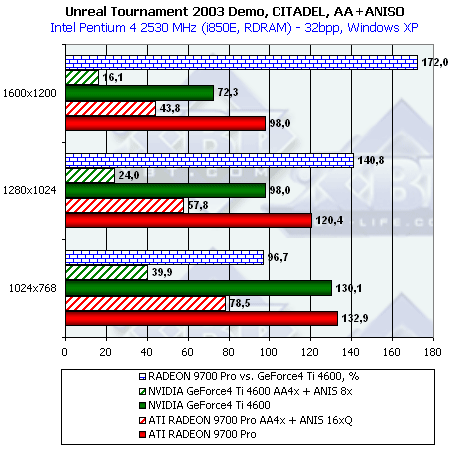
ANTALUS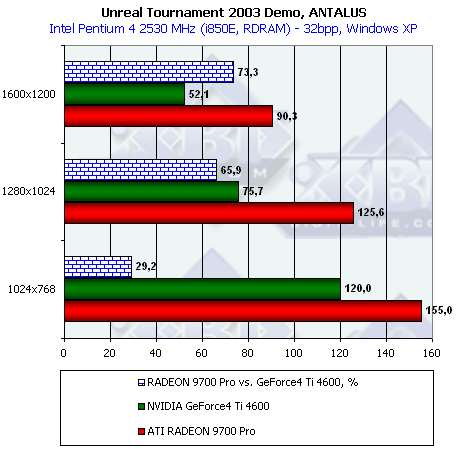
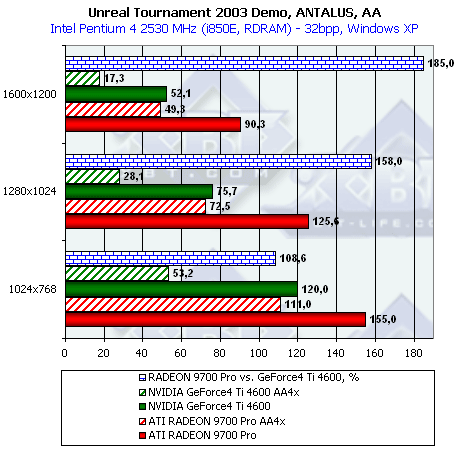 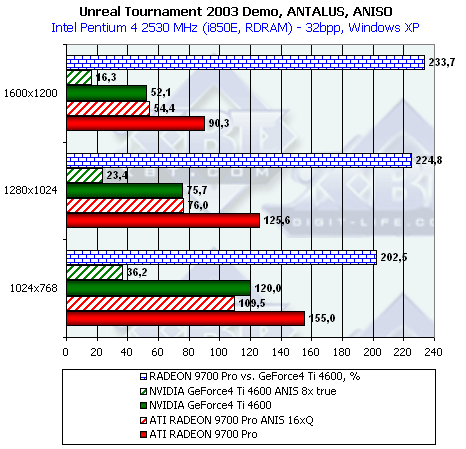
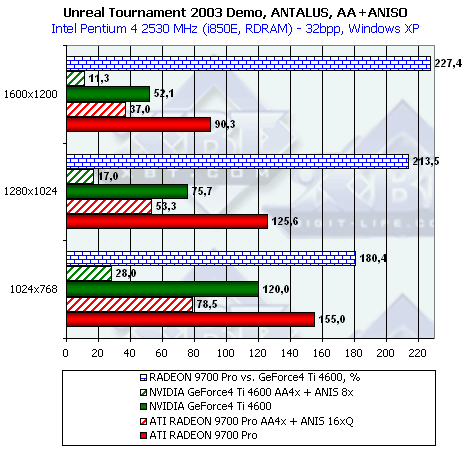
When we used the beta version of the DEMO (b.927) the test looked ridiculous, but the day before the release of the official DEMO we found out that the ATI based video cards fall so much behind because of texture compression disabled in the ATI drivers (to make the tests without S3TC/DXTC). However, the UT2003 seems to be using precompressed textures, and cards based on other chipsets could use it because, for example, in all GeForces it's impossible to switch off texture compression in the driver settings. The cards were in unequal positions. Now it's corrected. The final version of the program showed excellent scores of the RADEON 9700 Pro. The best results are achieved in the heavy tests involving AA and/or anisotropy. Well, the RADEON 9700 Pro outscores the GeForce4 Ti 4600 in average by 43.1% without AA or anisotropy, by 146.6% with AA, by 158.3% with anisotropy and by 160.2% with AA and anisotropy. Taking into account that the RADEON 9700 Pro is 40% dearer than the GeForce4 Ti 4600: the solution looks much more advantageous, though at such a price far not everyone can afford it. But there are still some problems with drivers and games. Let me quote one of our readers, an expert in the sphere of 3D accelerators, Viktor Poluektov: The anisotropy quality is improved. There are no more stripes around in the open. But RIP mapping is RIP mapping... First of all, if the floor is not even and it has a relief made of polygons, some of them will differ from the others in the way the textures are turned - and this is very noticeable. Secondly, in the 3DMark2001 in the fillrate tests with anisotropy there are two jerks in the beginning (lasting half a second). It's evidently connected with generation of RIP mapping. Although the ANISO16 provides higher sharpness and lower performance hit than the ANISO8 on the GF4Ti, the second looks better.I hope that in our next review on the RADEON 9700 I will look into the problems our readers bring forward. I also hope the experts from ATI will do their best to eliminate all of them. ConclusionThe main point is that the RADEON 9700 Pro, despite all its flaws in the drivers, entered the market successfully as the cards priced at $400-420 are disappearing from the shelves promptly.We haven't examined operation of such cards in the DirectX 9.0 with normal drivers developed for this API, that is why this solution will often be paid attention to till the DX9. So far we couldn't study operation of the AGP 8x on the RADEON 9700 Pro because the manufacturers try to clear up the problem. Besides, it's impossible to estimate difference between the 4x and 8x modes because of lacking normal tools for switching between the AGP modes. The Hercules 3D Prophet 9700 Pro 128MB card is perfect! It can boast of an elegant design with an original cooler, a wonderful build quality and a weighty accessory pack. I hope it won't be pricier than other RADEON 9700 Pro based cards. P.S. At present we have nothing to say about the NVIDIA NV30... :-)
Andrey Vorobiev (anvakams@ixbt.com)
Write a comment below. No registration needed!
|
Platform · Video · Multimedia · Mobile · Other || About us & Privacy policy · Twitter · Facebook Copyright © Byrds Research & Publishing, Ltd., 1997–2011. All rights reserved. | |||||||||||||||||||||||||||||||||||||||||||||||||||||||||||||||||||||||||||||||||||||||||||||||||||||||||||||||||||||||||||||||||||||||||||||||||||||||||||